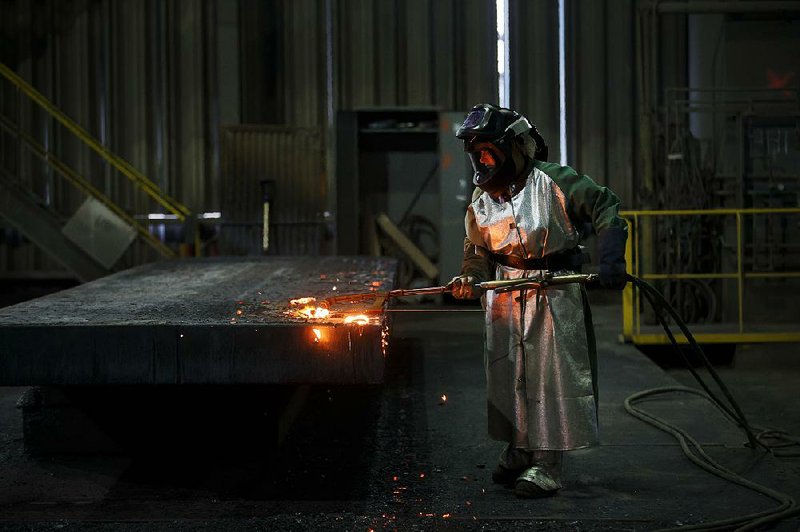Winter is coming and Stelco Holdings' steel plant on the Canadian shore of Lake Erie is stocking up for the stormy months ahead. Iron ore from Minnesota and Appalachian coal are streaming off ships on conveyor belts toward the blast furnace and coke ovens. Behind the docks, 25-ton coils of steel are lined up for shipment, still radiating heat three days after they were produced.
After decades of crisis, a renewed sense of purpose has settled over the 107-year-old company, which just completed the first initial public offering of a North American steel-maker in seven years. The question hanging over the reinvigorated enterprise is whether Stelco is finally on the cusp of sustained profitability, or whether it will wilt in an industry dominated by global giants and cheap Asian producers.
In the pantheon of great Canadian corporate names, Stelco doesn't exactly scream confidence. The Hamilton, Ontario-based Steel Company of Canada was once the country's biggest producer, with a workforce of 25,000 in the 1970s.
It's since gone through two stints in creditor protection while it struggled with operating losses, bitter labor relations, high debts and pension deficits. Its most recent owner, U.S. Steel Corp., plucked some of Stelco's best contracts and abandoned what was left of the company in 2015. Ahead, the winter freeze is the least of its worries as protectionist moves in the U.S. threaten to restrain its ability to expand in North America.
Who in their right mind would want to take control of such a business?
There's Alan Kestenbaum, 55, a Brooklyn-born turnaround artist who's now Stelco's principal owner and chief executive. Where others see a picked-over carcass, Kestenbaum sees an agile global player. Where some see old facilities and a potentially fractious workforce, Kestenbaum talks up unused capacity, strategic locations on the Great Lakes and fixable labor relations.
Investors seem willing to give him the benefit of the doubt, for now. Stelco's stock is up almost 13 percent since the company's $13.22-a-share early-November IPO, giving it a market value of about $1.3 billion. Bank of Montreal analyst David Gagliano initiated coverage with an "outperform" rating and a price target of $17.90, saying, "Stelco represents a compelling investment vehicle within the North American steel sector."
Purchased through Kestenbaum's Miami-based private-equity firm Bedrock Industries Group in June, Stelco has major advantages over some of its predecessors and competitors. After $3.4 billion of debt and pension obligations were eliminated through a restructuring that ended this year, Stelco has a clean balance sheet, along with $179 million of fresh cash raised in the IPO. The company says in its prospectus its total costs are "among the lowest in North America" and it expects its margins to expand as it uses more of its assets and regains lost volume.
What's more, Kestenbaum has a track record of finding and turning around struggling metal companies at Globe Specialty Metals Inc. in Miami, which he bought for $1 million in 2006. After 11 acquisitions and a merger with Grupo FerroAtlantica, London's Ferroglobe PLC is now worth about $2.7 billion. Kestenbaum believes he can achieve similar returns at Stelco.
"Two or three more acquisitions down the road and we'll turn around and we'll be $6 billion [in Canadian currency], $7 billion, $8 billion, why not?" Kestenbaum said in an interview at Stelco's Lake Erie Works in Nanticoke, Ontario.
The company declined to say how much Bedrock invested in the Stelco acquisition.
Joe Ragan, who worked as Kestenbaum's chief financial officer at Globe Specialty Metals, says the man has "the magic."
"He always gets an extraordinary deal for the assets he buys," Ragan, now Ferroglobe's CFO, said of his former boss. "He's got a very sharp acuity on how to structure a deal to get a really good value."
Forces beyond Kestenbaum's control also have been moving in Stelco's favor. Steel prices have been rising as China, the world's biggest producer, takes steps to reduce output to cut pollution and close illegal and inefficient plants, while prices for key inputs iron ore and metallurgical coal have declined in the past year.
The near-term picture, though, looks less rosy. The unpredictability of the North American Free Trade Agreement talks is a risk for Stelco and its ability to win U.S. contracts. If Stelco gets through that unscathed, the Trump administration may still follow through on threats to slap tariffs on steel imports, or otherwise ramp up Buy American provisions limiting the use of foreign steel.
Kestenbaum says his new company is ready for the worst. On the threat of reduced access to the U.S., he points out he's also looking to boost sales to Mexico and Europe, taking advantage of the company's location on the Great Lakes. And he says he'll be more careful than previous owners in preserving a clean balance sheet.
"You don't take on debt that can only be repaid in optimal market conditions," he says.
Back on the Lake Erie dock, the CEO will soon begin ramping up exports from a port that was primarily built for imports, with a goal of eventually exporting 500,000 to 1 million tons of steel a year to customers around the world.
"We look at ourselves as a global player," Kestenbaum says.
Information for this article was contributed by Joe Deaux of Bloomberg News.
SundayMonday Business on 12/10/2017

